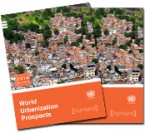
Today, 54 per cent of the world’s population lives in urban areas, a proportion that is expected to increase to 66 per cent by 2050. Projections show that urbanization combined with the overall growth of the world’s population could add another 2.5 billion people to urban populations by 2050, with close to 90 percent of the increase concentrated in Asia and Africa, according to a new United Nations report launched today.
The 2014 revision of the World Urbanization Prospects by UN DESA’s Population Division notes that the largest urban growth will take place in India, China and Nigeria. These three countries will account for 37 per cent of the projected growth of the world’s urban population between 2014 and 2050. By 2050, India is projected to add 404 million urban dwellers, China 292 million and Nigeria 212 million.
With nearly 38 million people, Tokyo tops UN’s ranking of most populous cities followed by Delhi, Shanghai, Mexico City, São Paulo and Mumbai
The urban population of the world has grown rapidly from 746 million in 1950 to 3.9 billion in 2014. Asia, despite its lower level of urbanization, is home to 53 per cent of the world’s urban population, followed by Europe with 14 per cent and Latin America and the Caribbean with 13 per cent.
The world’s urban population is expected to surpass six billion by 2045. Much of the expected urban growth will take place in countries of the developing regions, particularly Africa. As a result, these countries will face numerous challenges in meeting the needs of their growing urban populations, including for housing, infrastructure, transportation, energy and employment, as well as for basic services such as education and health care.
“Managing urban areas has become one of the most important development challenges of the 21st century. Our success or failure in building sustainable cities will be a major factor in the success of the post-2015 UN development agenda,” said John Wilmoth, Director of UN DESA’s Population Division.
Mega-cities with more than 10 million people are increasing in number
The report notes that in 1990, there were ten “mega-cities” with 10 million inhabitants or more, which were home to 153 million people or slightly less than seven per cent of the global urban population at that time. In 2014, there are 28 mega-cities worldwide, home to 453 million people or about 12 percent of the world’s urban dwellers. Of today’s 28 mega-cities, sixteen are located in Asia, four in Latin America, three each in Africa and Europe, and two in Northern America. By 2030, the world is projected to have 41 mega-cities with 10 million inhabitants or more.
Tokyo remains the world’s largest city with 38 million inhabitants, followed by Delhi with 25 million, Shanghai with 23 million, and Mexico City, Mumbai and São Paulo, each with around 21 million inhabitants. Osaka has just over 20 million, followed by Beijing with slightly less than 20 million. The New York-Newark area and Cairo complete the top ten most populous urban areas with around 18.5 million inhabitants each.
“Managing urban areas has become one of the most important development challenges of the 21st century. Our success or failure in building sustainable cities will be a major factor in the success of the post-2015 UN development agenda”
John Wilmoth
Director of UN DESA’s
Population Division
Although Tokyo’s population is projected to decline, it will remain the world’s largest city in 2030 with 37 million inhabitants, followed closely by Delhi, whose population is projected to rise swiftly to 36 million in 2030. While Osaka and New York-Newark were the world’s second and third largest urban areas in 1990, by 2030 they are projected to fall in rank to the 13th and 14th positions, respectively, as mega-cities in developing countries become more prominent.
Small cities are numerous and many are growing rapidly
Overall, nearly half of the world’s 3.9 billion urban dwellers reside in relatively small settlements with fewer than 500,000 inhabitants, while only around one in eight live in the 28 mega-cities with 10 million inhabitants or more. Many of the fastest growing cities in the world are relatively small urban settlements.
Rural populations expected to decrease as urban populations continue to grow
The rural population of the world has grown slowly since 1950 and is expected to reach its peak around 2020. The global rural population is now close to 3.4 billion and is expected to decline to 3.1 billion by 2050. While Africa and Asia are urbanizing rapidly, the regions are still home to nearly 90 per cent of the world’s rural population. India has the largest rural population with 857 million, followed by China with 635 million.
Sustainable urbanization is key to successful development
The report notes that a successful urban planning agenda will require that attention be given to urban settlements of all sizes. If well managed, cities offer important opportunities for economic development and for expanding access to basic services, including health care and education, for large numbers of people. Providing public transportation, as well as housing, electricity, water and sanitation for a densely settled urban population is typically cheaper and less environmentally damaging than providing a similar level of services to a dispersed rural population.
The 2014 revision of the World Urbanization Prospects provides new and updated information on global urbanization trends and city growth. Such information is vital for setting policy priorities to promote inclusive, equitable and sustainable development for urban and rural areas alike. Recognizing the importance of smaller cities and towns, this latest revision expands the number of cities and provides, for the first time, population estimates and projections for all of the world’s urban settlements with 300,000 inhabitants or more in 2014.
